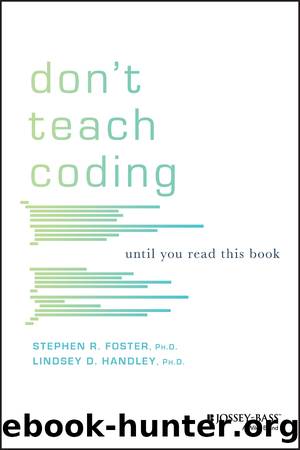Don't Teach Coding by Lindsey D. Handley & Lindsey D. Handley

Author:Lindsey D. Handley & Lindsey D. Handley [Foster, Stephen R. & Handley, Lindsey D.]
Language: eng
Format: epub
ISBN: 9781119602637
Publisher: Wiley
Published: 2020-04-21T00:00:00+00:00
Our analog digits do have one magic power that paper and pencil lack: The calculations leave no trace. Those who have learned the art of dactylonomy can close their eyes, wiggle their fingers in what looks like an arcane spell, performing additions, subtractions, divisions, multiplications, square root approximations, and more – all with a high degree of accuracy and not a single lasting change in the environment around them. The fingers serve as storage – but only temporary, ephemeral storage. It was the original “digital storage,” a safe and private place because of its ephemerality.
It is a strange kind of sign language – certainly capable of communicating one's mathematical thoughts to other fluent practitioners. But its true value seems to be less about others, more about oneself, more about aiding a certain kind of cognition. This sign language is a tool of the mind.
The art of dactylonomy is by no means lost to antiquity either. In the 1970s, American schools began to pilot an initiative to teach Chisanbop – a finger counting system invented in Korea. The method is an application of abacus-based arithmetic to the fingers, allowing the numbers 0 through 99 to be rapidly manipulated on two hands. Although many teachers were enthusiastic about the results, the initiative was dropped.
Perhaps this was done too hastily, however. In 2011, scientists began to once again question the traditional aversion to finger counting (Moeller et al. 2011). Recent research indicates that an awareness of one's fingers is an early predictor of numerical ability in children. Even adults when doing mental math inside an fMRI have been shown to activate neurological circuitry related to finger motions (Soylu et al. 2017). In 2017, at least one study showed that finger training for children can increase mathematical ability (Jay and Betenson 2017).
This being a book about teaching coding, we will not weigh in on the debate about dactylonomy. Rather, the debate itself serves to illustrate a deeper point – one that is less about mathematics and more about the relationship between the mind, the body, the external world, where a “computation” happens, and how that has changed throughout history.
A historical lens is key.
Computations that happen in software today once happened in the minds of yesterday. As educators in the age of software, the decisions we make about what computations to teach to the minds of today must always be informed by what the programming languages of tomorrow will be capable of.
Luckily, understanding the history of externalization is the key to understanding its future. For it has a kind of momentum to it.
Download
This site does not store any files on its server. We only index and link to content provided by other sites. Please contact the content providers to delete copyright contents if any and email us, we'll remove relevant links or contents immediately.
The Art of Coaching Workbook by Elena Aguilar(50872)
Trainspotting by Irvine Welsh(21488)
Twilight of the Idols With the Antichrist and Ecce Homo by Friedrich Nietzsche(18477)
Fangirl by Rainbow Rowell(9071)
Periodization Training for Sports by Tudor Bompa(8145)
Change Your Questions, Change Your Life by Marilee Adams(7610)
This Is How You Lose Her by Junot Diaz(6761)
Asking the Right Questions: A Guide to Critical Thinking by M. Neil Browne & Stuart M. Keeley(5603)
Grit by Angela Duckworth(5497)
Red Sparrow by Jason Matthews(5368)
Paper Towns by Green John(5065)
Room 212 by Kate Stewart(5014)
Ken Follett - World without end by Ken Follett(4620)
Housekeeping by Marilynne Robinson(4306)
The Sports Rules Book by Human Kinetics(4272)
Double Down (Diary of a Wimpy Kid Book 11) by Jeff Kinney(4183)
Papillon (English) by Henri Charrière(4176)
The Motorcycle Diaries by Ernesto Che Guevara(3989)
Exercise Technique Manual for Resistance Training by National Strength & Conditioning Association(3934)
